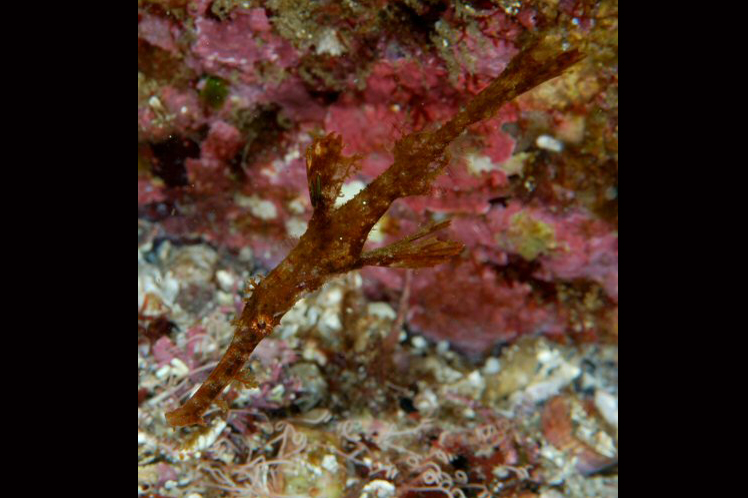Delicate Ghostpipefish, Solenostomus leptosoma Tanaka 1908

Delicate Ghostpipefish, Solenostomus leptosoma, on the Izu Peninsula, Japan, depth 5 m. Source: Izuzuki / www.izuzuki.com. License: CC by Attribution-ShareAlike
A small reddish, reddish-brown or dark brown ghostpipefish with whitish mottling, blotches and spots, and often a whitish streak along the midsides.
There is little documentation of the distribution of the species in Australia and no specimens from Australia have been identified as this species. Occurrence in Australia is based on Allen & Erdmann (2012) and Kuiter (2009). Some workers included Solenostomus leptosoma as a junior synonym of S. paradoxus (see Kuiter 1993). Orr & Fritsche (1993) treated the species as of uncertain status. Orr et al (2002) also did not recognise S. leptosoma and regarded the usage by Kuiter (2000) for S. leptosoma as based on an undescribed species. Consequently the name used here is tentative.
Delicate Ghostpipefish, Solenostomus leptosoma Tanaka 1908
More Info
|
Distribution |
Eastern Australia. Elsewhere the species occurs in the Indo-west Pacific from Mauritius to eastern Australia. Inhabits sandy areas at the reef edge, although the species seems to be mostly pelagic. |
|
Features |
Dorsal fin V + 18-21; Anal fin 18-21; Pectoral fin 25-28. |
|
Size |
|
|
Colour |
|
|
Feeding |
|
|
Biology |
Ghostpipefish are external skin-brooders and eggs hatch and develop within a pouch formed by the fused pelvic fins of the female. The embryos are enclosed in egg envelopes attached to outgrowths (cotylephores) of the skin on the internal surface of the pelvic fins. These structures are only present in brooding females and may function in metabolic exchange between the female and her embryos. Following hatching, the embryos are released as independent free-swimming young through a slit on the right side of the brood pouch. Eggs - small, spherical. Larvae - the well-developed larvae hatch at about 3 mm, with pigmented eyes, a fully formed mouth and advanced body spination. |
|
Fisheries |
Of no commercial importance to either fisheries or aquaculture. Although desired by aquarists, ghostpipefish are very difficult to rear in captivity. |
|
Conservation |
Marine Listed under the Federal Environment Protection and Biodiversity Conservation Act 1999 (EPBC Act). http://www.environment.gov.au/epbc/species/marine.html |
|
Remarks |
There is little documentation of the distribution of the species in Australia and no specimens from Australia have been identified as this species. Occurrence in Australia is based on Allen & Erdmann (2012) and Kuiter (2009). Some workers included Solenostomus leptosoma as a junior synonym of S. paradoxus (see Kuiter 1993). Orr & Fritsche (1993) treated the species as of uncertain status. Orr et al (2002) also did not recognise S. leptosoma and regarded the usage by Kuiter (2000) for S. leptosoma as based on an undescribed species. Consequently the name used here is tentative. |
|
Etymology |
Solenostomus is from the Greek soleno (= tubelike) and stoma (= mouth). The specific name leptosoma is from the Greek leptos (= slender) and soma (= body), presumably in reference to the “body elongate, much compressed”. leptos, slender; soma, body, |
|
Species Citation |
Solenostomus leptosoma Tanaka, 1908, Annotationes Zoologicae Japonenses 7(1): 29. Type locality: Yodomi, Sagami Sea, Japan. |
|
Author |
Bray, D.J. 2020 |
|
Resources |
Delicate Ghostpipefish, Solenostomus leptosoma Tanaka 1908
References
Allen, G.R. & Erdmann, M.V. 2012. Reef fishes of the East Indies. Perth : Tropical Reef Research 3 vols, 1260 pp.
Kuiter, R.H. 1993. Coastal Fishes of South-eastern Australia. Bathurst : Crawford House Press 437 pp. (p. 82, upper figure, as a junior synonym of Solenostomus paradoxus)
Kuiter, R. H. 2009. Seahorses and their relatives. Aquatic Photographics, Seaford, Australia. 333 pp.
Kuiter, R.H. & Tonozuka, T. 2001. Pictorial guide to Indonesian reef fishes. Part 1. Eels- Snappers, Muraenidae - Lutjanidae. Zoonetics, Australia. 302 pp.
Orr, J.W., Fritzsche, R.A. & Randall, J.E. 2002. Solenostomus halimeda, a new species of ghost pipefish (Teleostei: Gasterosteiformes) from the Indo-Pacific, with a revised key to the known species of the family Solenostomidae. Aqua, Journal of Ichthyology and Aquatic Biology 5(3): 99-108 (as a synonym of Solenostomus paradoxus)
Tanaka, S. 1908. Descriptions of eight new species of fishes from Japan. Annotationes Zoologicae Japonenses 7(1): 27-47 figs 1-2 See ref at BHL
Senou, H. 1994. A review of the ghost pipefishes, genus Solenostomus (Teleostei: Solenostomatidae) from Japan. I.O.P. Diving News 5(6): 2-6 [in Japanese]
Whitley, G.P. 1952. Figures of some Australian fish types. Proceedings of the Royal Zoological Society of New South Wales 1951-52: 23-31 figs 1-8 (as Solenichthys leptosomus) See ref at BHL


